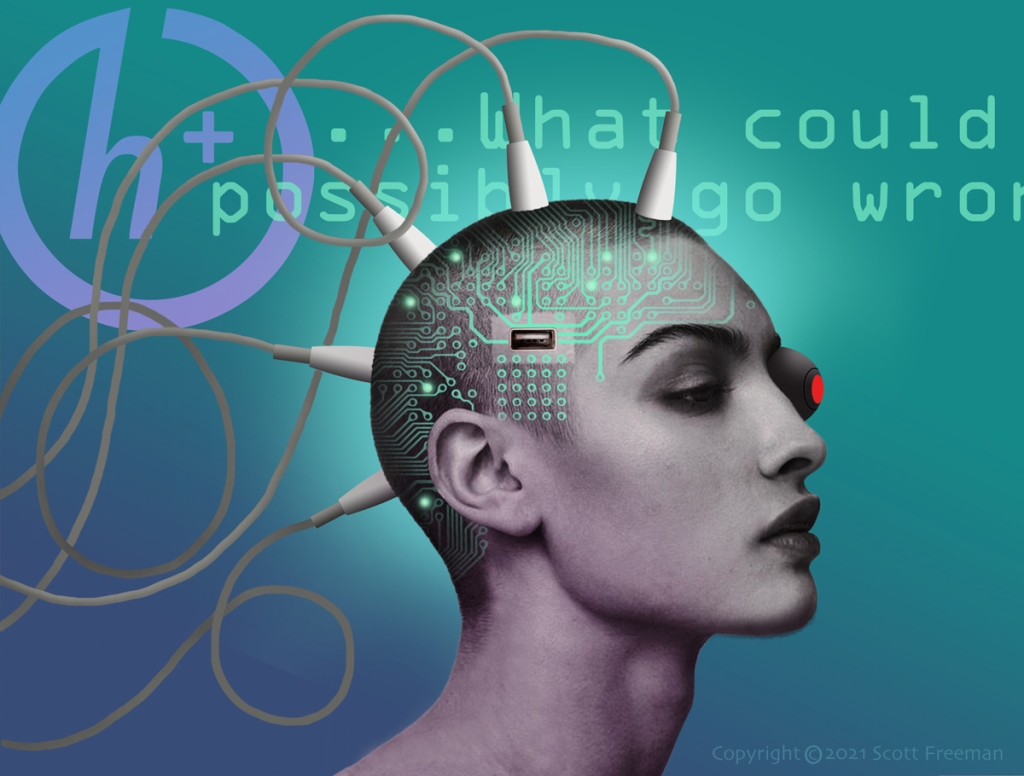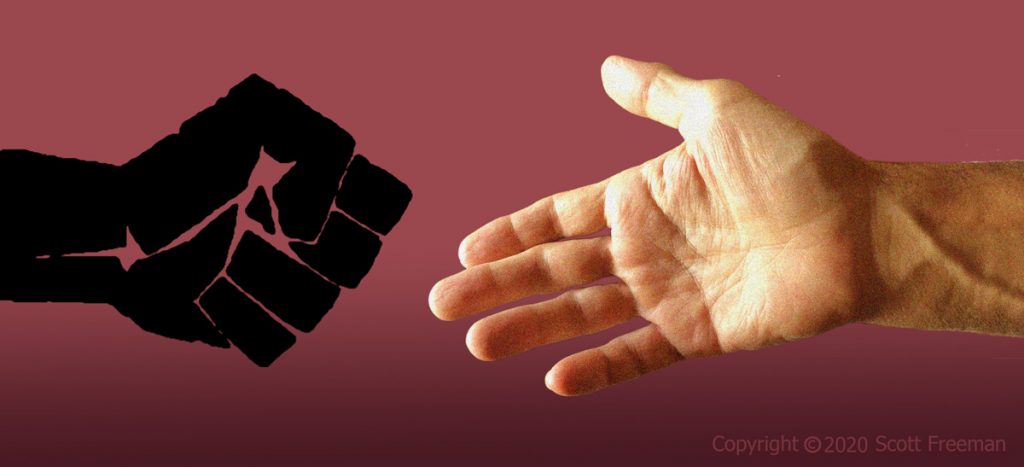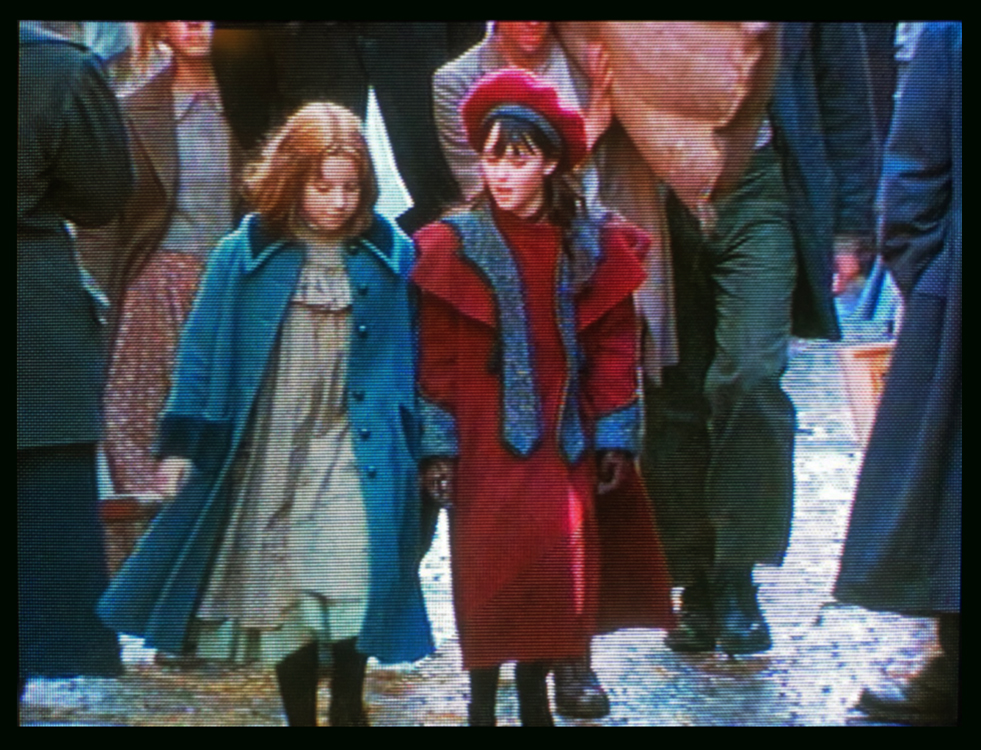
I won’t make you wait for it. The word is Transhumanism.
This is a revolution that no one is talking about. Where are the news media and where are the “experts” on this? We should be having a national discussion around whether we even want to be on board with the dubious idea of transhumanism, and, for those who do, how they should cautiously proceed. Instead we are barreling down the transhuman highway with the windshield painted fuchsia.
What is Transhumanism? (Abbreviated as H+)
Transhumanism is a philosophical movement opining that we can and should overcome the natural biological limitations of humanity by means of science and technology. Some transhumanists envision enhancing human longevity and cognitive abilities to the degree that humans become “posthuman” creatures.
H+ stems from an evolutionary worldview. It is a perfectly reasonable conclusion, if one believes in a mindlessly and accidentally evolved universe, that we should intelligently direct the course of our own evolution now that we have the means to do so.
Here’s an illustrative quote from one transhumanist:
We believe it is our basic human right to be able to upgrade ourselves, and to develop and leverage the fundamental technologies that enable the next phase of evolution. We believe the future of the human race will not only allow us to opt out of nature’s selective processes and choose our own evolutionary paths, but that our very survival as a species depends on it. These beliefs are the cornerstone of Transhumanism. (Amal DT Graffstra).
To clarify, H+ is not the use of science and technology to restore the body’s natural functions or to facilitate healing. That is the role of traditional medical science. Nor is H+ the use of technology to restore disfigurement, or even to enhance one’s physical attractiveness. That is the role plastic/cosmetic surgery. Rather H+ seeks to transcend our natural human limitations and engineer an improved humanity.
The issue here is not science vs anti-science. The issue at hand is around what should be the legitimate role of science and technology.
Transhumanism is already here
My guess is that most people don’t recognize the revolution for what it is because, if we’ve thought about it at all, we think of transhumanism as a futuristic, sci-fi fantasy. And it’s true that we aren’t yet capable of brain-machine interfaces, or mastering the aging process. But there is a sub-category of transhumanism that is not waiting for the future. That sub-category is called postgenderism.
Postgenderism seeks to use science and technology to create a world where human beings are free from the “harmful constraints” of the traditional binary concept of gender:
Postgenderism is an extrapolation of ways that technology is eroding the biological, psychological and social role of gender, and an argument for why the erosion of binary gender will be liberatory. Postgenderists argue that gender is an arbitrary and unnecessary limitation on human potential, and foresee the elimination of involuntary biological and psychological gendering in the human species through the application of neurotechnology, biotechnology and reproductive technologies… Assisted reproduction will make it possible for individuals of any sex to reproduce in any combinations they choose, with or without “mothers” and “fathers,” and artificial wombs will make biological wombs unnecessary for reproduction… Postgenderists do not call for the end of all gender traits, or universal androgyny, but rather that those traits become a matter of choice…
(Beyond the Gender Binary, Dvorsky and Hughes, 2008).
Notice that like H+, and as a sub-category of H+, postgenderism:
1) is a utopian endeavor,
2) seeks to override or transcend natural human limitations.
3) employs science and technology to carry out its aims
To be charitable, H+ and it offshoot, postgenderism, hope to improve the human condition and relieve human suffering, including “psychic suffering”. But the crucial question is, “Does it, can it, and will it deliver?” I think we have reason to be very concerned about the answer.
From the standpoint of a biblical worldview, the fundamental problems with the human condition are beyond that which science and technology can fix. It is indicative of human arrogance to assume we can improve upon our natural humanity through technological means.
Present day examples of H+/postgenderism
If it seems like a stretch to believe that H+/postgenderism is here, think about what is routinely happening today in the field of human sexuality. I should state that I am not a medical professional of any stripe, but as a layman, three current examples with which we are all now familiar come to mind:
1) Abortion-on-demand – Consider this through the lens of postgenderism. Abortion-on-demand is now non-negotiable for modern feminism because, to the feminist mind, human biology renders men and women “unequal.” The possibility of abortion access erases the inequity that nature imposes upon women, thus making gender at least somewhat less relevant. In the feminist mind, without abortion, natural female biology is seen as a form of slavery; a social injustice; a limit on female autonomy. If planning and/or contraception fail, abortion allows women to overcome their biological limitations – thus abortion qualifies as a crude H+ half measure until the development of the artificial womb.
Note that elective abortion falls outside the parameters of healing medicine: pregnancy is not a disease. A developing embryo is not an invasive parasite. A fetus is not a tumor. Elective abortion exists in America for ideological reasons. For the immediate future, the cutting edge of the abortion industry seeks a “safe” abortive chemical solution, making abortion access less dependent on invasive surgical procedures and more widely available.
2) Hormone therapy and puberty blocking drugs – Researchers have learned some of the mechanics of how hormones work, and why males and females develop the way they do. We can now appropriate technology to artificially delay puberty, and to alter the body’s natural processes to create secondary sexual features like facial hair and breasts. Transgender individuals are appropriating this technology to bring their bodies into alignment with their psychical identity.
Whether or not this is a good idea is another conversation. My point here is that it is undeniable that such chemical therapy is now commonplace, and it falls squarely under the agendas of H+/postgenderism – it is the use of science and technology to transcend one’s natural physiology for conceptual reasons.
3) Sex reassignment surgery – Surgically altering healthy, functioning sex organs is an extreme procedure from which there is no going back, practically speaking. Doing so for ideological reasons is a clear example of H+/postgenderist practice.
In my non-expert opinion, I would concede that there are a number of developmental sexual abnormalities for which such therapy and surgeries would arguably constitute a legit medical fix. But for purposes of this discussion it is the H+/postgender vision of a society where gender is considered to be a fluid, non-binary, matter of choice for everyone, including children, that I’m concerned with.
Why does this matter for you?
Progressive ideologues are imposing H+/postgenderism onto the culture under the guise of justice and equality. We are told that the changes around gender ideology are simply the next, inevitable stage of the civil rights movement. So compassionate people cannot disagree with what is happening. You want to be a compassionate person, don’t you? This is all about minimizing suffering.
Perhaps this all seems to have come from out of nowhere to you. Like an accidental explosion at the cotton candy factory, sending sticky wisps of rainbow-colored spun sugar down on us all. What I would like the reader to consider is that these societal changes have been inspired by “progressive” political ideology, and they have been in the making for decades. One can map the progress.
I am unequivocally on board with compassion, fairness, equality, and minimizing suffering, but the changes stemming from gender ideology are not some inevitable next stage in social progress based on scientifically informed reason. They are changes stemming from the opinions of ideologically driven activists. No one should feel pressure to get on board.
This is about authority
The point of this article is not so much to convince those with whom I disagree of the rightness of my position. My point is to amplify the logical consequences of two differing worldviews in the interest of enabling people to make informed choices.
This is ultimately about authority. Transhumanism and postgenderism stem from a specific set of beliefs about the universe. If one believes that we exist as a result of purposeless, accidental, evolutionary processes, then natural law and human biology carry little weight. They simply exist, for no authoritative reason. We are free to take control of the reigns and to direct our destiny as we see fit. On paper, at least, there is little to prevent us from creating our own reality.
But a lot of ideas sound good on paper. Car alarms and self-flushing toilets, for example. Nevertheless, whether we like it or not, human brokenness always gets in the way of utopia in this present age.
By contrast, followers of Jesus embrace a different set of beliefs about the universe. We believe that objective, divine authority actually exists; that it always has, and it always will. The gospel of Matthew quotes Jesus’s last statement to His disciples:
“All authority in heaven and earth has been given to me…”
That’s an extravagantly bold statement coming from a figure who is universally regarded as being a good teacher. Followers of Jesus are bound to believe it. Jesus and His disciples also made definitive statements about gender, marriage, family, the innate value of human life, and the unreliability of the human heart. These statements are simply not compatible with H+/postgenderism.
An “upgrade” for humanity is indeed coming, but according to Jesus and His disciples it will come from the Author of Life, not from our own H+ biohacking. In the meantime, in this age, it seems clear to me that we don’t have all the information, and that therefore, apart from revelation, we often don’t know what’s best for ourselves and for each other.

If you’re a liberal, you might object that your beliefs have nothing to do with an H+/postgenderist agenda. You might argue that you believe in an infinite spectrum of genders for reasons of fairness; that “gender is what’s between your ears” is the more compassionate position; that you believe that “what matters is two loving parents, more so than a biological mom and dad” for reasons of inclusivity; that you support abortion-on-demand in support of “reproductive freedom” for women, and so on.
However, those reasons notwithstanding, one is still embracing T+/postgenderist thinking if one is favorable to the use of technology to transcend our natural human limitations. One is establishing oneself (or humanity) as the ultimate authority in defining and determining enlightenment, morality, and salvation. A line from The Humanist Manifesto ll comes to mind, published in 1973, the year of the Roe v Wade decision:
“No deity will save us; we must save ourselves.”
So how do we live together?
This is a fascinating time to be alive. The choices before us couldn’t be more consequential. The consequences of choosing wrongly couldn’t be more perilous, from the standpoint of both worldviews. And yet, it is essential that we all live together peaceably and respectfully. How can we do this, given this extreme disparity of belief?
I contend that as Americans, we can still unite around the practice of pluralism and freedom for all within the constraints of the US Constitution. That includes free speech, a free press, religious liberty, and respecting parents’ rights to raise their own children as they see fit. All sides must be on guard against totalitarian thinking. All sides must be on guard against magical thinking. Amongst those with whom we agree, it would make the world a better place if we would hold each other to a standard of honesty, compassion, and respect for the individual.
I welcome your thoughts in the comment section.
— Scott Freeman, July 2021










